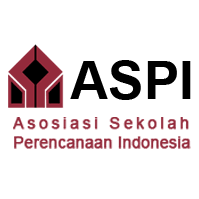INTEGRATED CITY CONCEPT IN JAKARTA CITY PLANNING
Abstract
This research was made as the first step to develop the city of Jakarta into an integrated pilot city area. Based on previous research on the development of the city of Jakarta assessed on sustainable urban planning and spatial planning, there is very little literature on Jakarta urban planning to achieve an integrated urban area. What is meant by compact city here is an area that grows and develops as a center for collection, processing, distribution and service of a development area designed as a structured development direction, both in design, facilities and infrastructure, spatial policies, vehicle circulation patterns, arrangement of river channels, pedestrians and urban green patterns. The method used is a combination of data collection with conceptual descriptions consisting of field observations, topography and evaluation of literature and policies with the limitations of this research problem on the concept of sustainable planning and policy evaluation in the development of the city of Jakarta into an integrated city. The results of this study are an integrated city is a city that pays attention to and seeks benefits from population density where an integrated city still maintains the comfort of its citizens in living their lives, the distance to shopping, work, school and others is short and comfortable even on foot. Apart from that, the integrated city also maintains the sustainability of its urban development in an ecological and democratic way for all citizens. The conclusion of this study is that the integrated city can be said to be a concept that fits the needs of the city of Jakarta today.
Downloads
Published
How to Cite
Issue
Section
License
Copyright (c) 2023 Desta Promesetiyo Bomo

This work is licensed under a Creative Commons Attribution 4.0 International License.
Authors who publish with this journal agree to the following terms:
- Authors retain copyright and grant the journal right of first publication with the work simultaneously licensed under a Creative Commons Attribution License that allows others to share the work with an acknowledgement of the work's authorship and initial publication in this journal.
- Authors are able to enter into separate, additional contractual arrangements for the non-exclusive distribution of the journal's published version of the work (e.g., post it to an institutional repository or publish it in a book), with an acknowledgement of its initial publication in this journal.
- Authors are permitted and encouraged to post their work online (e.g., in institutional repositories or on their website) prior to and during the submission process, as it can lead to productive exchanges, as well as earlier and greater citation of published work (See The Effect of Open Access).


















